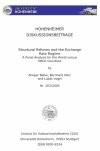
Structural Reforms and the Exchange Rate Regime
A Panel Analysis for the World versus OECD Countries
Beitrag, Englisch, Universität Hohenheim
Autor: Prof. Dr. Ansgar Belke
Herausgeber / Co-Autor: Bernhard Herz, Lukas Vogel
Erscheinungsdatum: 2005
Quelle: Hohenheimer Diskussionsbeiträge 263/2005
Aufrufe gesamt: 785, letzte 30 Tage: 1
Kontakt
Verlag
Universität Hohenheim Fakultät Wirtschafts- und Sozialwissenschaften Fachgebiet Außenwirtschaft
Telefon: +49-711-459-3246
Telefax: +49-711-459-3815
Preis: Kostenlos
DE, Essen
Inhaber des Jean-Monnet Lehrstuhls VWL, insbes. Makroökonomik an der Universität Duisburg-Essen
ECB-Observer
Publikationen: 133
Veranstaltungen: 4
Aufrufe seit 04/2005: 12515
Aufrufe letzte 30 Tage: 24



